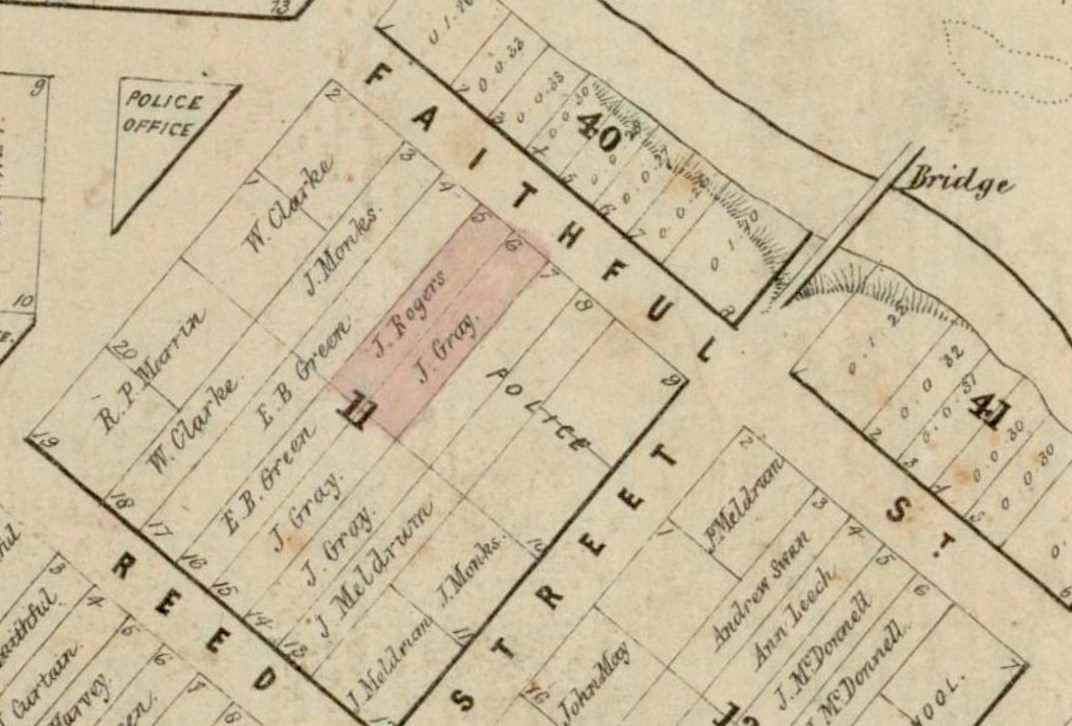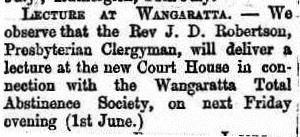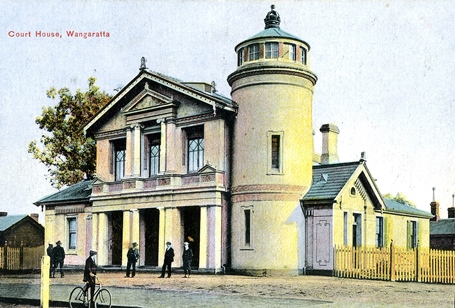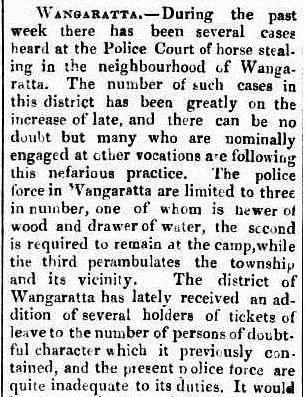Following on from the last Trove Tuesday we continue reading an account of Wangaratta published in the Ovens & Murray Advertiser (O&MA) in January 1863.
Having reviewed the temples of Bacchus, we naturally turn to the temple of Themis. This is represented by a building of brick, which, if Colonial bricks and mortar, and Colonial contractors, had done their work as well as had been hoped, or intended, would be an ornament to the town, and a convenient and comfortable establishment for its frequenters, whether J.P.s, inebriates, clerks, reporters, or policemen. As it is, the building is tumbling down.
The Temples of Bacchus mentioned in the last Trove Tuesday post referred to the Roman god of wine. Again the writer of this piece shows off his classical education by referring to the temple of Themis. Themis was a Greek Titaness who was “the personification of divine order, law, natural law and custom”. The reference is rather amusing as in 1863 Wangaratta was far from the epitome of law and order. Perhaps fittingly, the building that was supposed to represent, and be the seat of law and order, was derelict.
Unfortunately Whittaker’s book on Wangaratta does not mention the court house at all, nor does Bill O’Callaghan. Graham Jones’ On This Day in the North East has no mention of the court house and his bicentary volume There Was a Time has no index. At around 270 pages I have been daunted by the task of indexing the book. You can see a combined index of other books relating to Wangaratta that I have indexed here. It is not even clear where this first court house stood. It was most likely on the block set aside for police use on the south west corner of Murphy and Faithfull streets but it is not clear if it faced Faithfull Street where the third Court House was eventually located, or Murphy Street. The blocks number 7, 8, 9, and 10 in section 11 notated “Police” in the map below were shown on an earlier map as being reserved for a church, school and parsonage.
£2,000 was set aside in early 1858 for a substantial court house at Wangaratta. It seems implausible that a building costing so much would be falling apart less than 5 years later. It seems more likely that the money was not used for a new building until after early 1863. A newspaper report in May 1866 supports this hypothesis.
Another report mentions the “old Court House” in August 1864, suggesting that the new building was erected between January 1863 and August 1864, and the old “tumbling down” court house continued to serve as a type of community center for at least a few years. The new Court House looked like this.
Facing Murphy Street on the corner of Faithfull Street, on allotment 9 shown in the map above, it must have been an imposing landmark. The tower is an unusual addition to a Court House. Reminiscent of a lighthouse it is taller than the Court House itself and would have provided unimpeded views of the country side. That the tower was positioned on the Ovens River side of the block is perhaps no accident. This was an era where ideas were at work everywhere. One of the ideas for transportation to close the gap on the “tyranny of distance” was to use paddle steamers on major river systems, an idea that worked well on the Murray River. The story of the navigation of the Ovens River is so interesting, I will not go off on a tangent with that story now, but will keep it for another time.
In September 1872 the Illustrated Australian News featured Wangaratta, stating:
There is, perhaps, no country town in Victoria that shows more signs of immediate progress than Wangaratta. Many new buildings have been recently erected. The old court–house has been renewed and coated with cement, and a new white railing substituted for the old broken fence.
This does perhaps throw my theory of Court Houses up in the air. Is the Court House in the above image the one that had been renewed and coated with cement? If so, it would actually be the first court house, and the second (new) building was probably in Faithfull Street where the Art Deco building stood for many years. I think this is probably not the correct interpretation of the Court House story as it seems unlikely that a rather cheaply built 1850s brick building could have been turned into something so substantial and attractive as the building with the tower – but I’ll keep an open mind. Unfortunately only images of this towered Court House in Murphy Street and the Art Deco Court House in Faithfull Street are publicly available. A map drawn up in the late 1860s or 1870s may be needed to solve the puzzle. Until something else is brought to my attention I’ll stick with my theory of the towered building being the second Court House.
Whatever the building it was housed in, a Court House was sorely needed in the growing community. Lawlessness wasn’t usual but it wasn’t unheard of either. Wangaratta’s problems were common throughout the colonies and in the late 1850s, so few police represented the district as to make it virtually un-policed.
Some sensational events did occur in the town but by the 1860s these had reduced in number. The Hobart based Colonial Times reported the following incident in 1853.
The usual accounts of “bailing up” and robberies occupy the papers. A desperate attack was made on Meldrum Hotel, at Wangaratta, by a mob of some twenty men, who attempted, in the middle of the day, to take forcible possession of the house. The inmates, however, with the assistance of some of the residents of Wangaratta, overpowered them, after a sanguinary battle, and gave them so sound a thrashing that they will probably never make a similar attempt again. The police, though their station was near, did not take any part in the matter.
The Wangaratta courthouse was the scene of many important events, perhaps the earliest and most important occurring in July 1863 when votes were counted in the first election for the Wangaratta Municipal Council. An account of the election which gives a nice insight into the personalities and factions of the contenders can be read here. Michael Cusack, along with his friend and my ancestor William Henry Clark and William Murdoch topped the poll. It is interesting that all three of the top pollers were publicans and all had businesses linked to each other. Announced by police magistrate R. W. Shadforth the results were:
Michael Cusack 89
William Clark 88
Wm. Murdoch 88
James Dixon 78
Edward Lucas 72
John Burrows 66
Alex. Tone 62
William Willis 58
D. H. Evans 47
W. A. Dobbyn 44
Andrew Swan 39
A. C. Bayly 37
Andrew Stark 31
Wm. Thomson 27
Samuel Norton 25
Edward Batchelor 16










Very interesting articles. Appreciate all the work put in by contributors.
That part of the building at the front which appears to be two storey probably isn’t. My experience of courthouses is that the upper windows are to bring daylight into the courthouse so Their Honours could see what they were writing. The lower level at the back may have been the original building.
Aaaah! Makes perfect sense. Could the “old” courthouse have actually been the rear section and the “new” courthouse the front part? And I wonder when exactly the tower was added? Questions, questions! The 1904 plan I will talk about in the next post shows the Courthouse as two storey but of course that may be nominal and may be more about what the frontage looked like rather than any actual second floor capacity. More research to do I think!
Gazette 96, Date: Friday, July 15th 1892 p2946 more additions to the courthouse to the value of 1,478 by J W Walter. Gazette 88, Date: Friday, June 30th 1893 p2866 another 44 pounds 14 shillings paid for extras on contract for additions and repairs to J W Walter.
Thanks for the tip Lenore,
I spent so long being totally absorbed in this post that I overlooked the GGs. And yes, a flood could absolutely have been a cause of damage to the building. I have since located a detailed plan of the town centre drawn in 1904 and updated several times until 1931. It’s hard work deciphering all the layers but the Courthouse was shown in 1904 as brick, of two stories and located exactly where the building in the image in this post was. More about that in the next post about the police buildings.
Jenny
Gazette 63, Date: Friday, June 21st 1878 p1463 An additional 37 pounds and 15 shillings to be paid for additional repairs to above contractor.
Gazette 111, Date: Thursday, November 08th 1877 p 2133 – Another 509 pounds for alterations and additions to the Wangaratta Courthouse, contractor this time was Thomas Heaton Amery.
I wonder if “additions” is significant here, and points to the addition of the single story at the rear? Although the cost of “alterations and additions” here is less than the 1869 “alterations” etc. I think I need a good trawl through PROV for plans. Also hoping the forthcoming release of The Age on Trove may hold some clues as that paper seemed to copy items from the Beechworth based Constitution. Oh for an 1870s map!
Victorian Government Gazette 70, Date: Friday, December 17th 1869 page 1996 shows a tender accepted for ‘Alterations, repairs and other works at Courthouse, Wangaratta, L799,’ from Lewis Griffiths. I’m not sure what you would get for 799 pounds. Could repairs have been needed due to floods? Maybe that repaired courthouse was included somewhere in the complex shown in the postcard. Further work in the VGG may be rewarding.